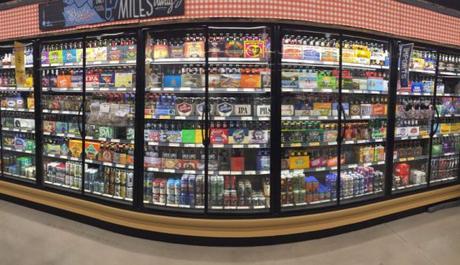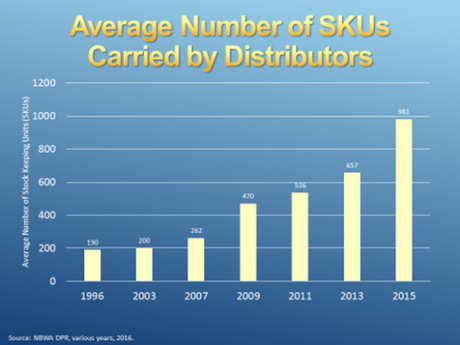
What a terrifying world we live in. Two breweries opening up each day. Stores stocking week-old beer. Shelves lined with bottles and cans as far as the eye can see.
"Our customers are thinking, 'how much more of an assortment can you carry?'" AB InBev CEO Carlos Brito recently told Just Drinks, adding that consumers are "a bit tired of choice and go for fewer brands."
The end is nigh. Or, at least, that's how the leader of the world's largest beer company would like you to see it. Because let's be honest, beer drinkers aren't taking to the streets to protest the volume of what's available to them. In many ways, they're embracing it.
There are specific problems facing beer sales, from maintaining flagship brands to warding off wine and spirits, but the idea of choice seems more like a welcomed challenge than worrisome threat. Brito's belief that "[t]here's only so much shelf space that you can share and cold box that you can split," is a factually accurate representation of store layout, but presenting an array of options isn't as cut and dry as he'd like you to think.
Instead let's focus on what's getting the most attention: the brunt of Brito's assertion. Are consumers "tired of choice"?
Evidence suggests he's wrong.
When discussing variety of choice and what it does to consumers, the most popular study cited is this one, about jam. The TL;DR version of that study is that when shoppers were presented with a collection of jams to buy using a coupon, fewer options (six jams) tallied more sales than more options (24 jams). Sheena Iyengar, a professor at Columbia University who oversaw the work, has done other experiments in this realm and even written a book.
But what if the reality of choice wasn't as simple as Iyengar's studies suggest? Additional research and commentary suggests that at worst, more choice may create a neutral impact, and with some further analysis, may even be better for beer drinkers.
Sorry, Carlos.
A key part of Brito's comments - whether purposeful or not - is something of a brilliant psychological maneuver. His claim that consumers are tired of too much choice can be left to the subjective reaction of anyone, but it is indeed fact that we have never had so much choice. Stockholders or Average Drinkers alike may hear this comment and think to themselves, "yes, the grocery store does seem to have way more beer than ever before," but it's action that counts. The volume of brands wouldn't be rising if people weren't interested, let alone if distributors thought they couldn't sell them.

Brito's claim of consumer fatigue, not backed by specific examples and data, falls more into the realm of pseudoscience than hardened fact. Instead, we can likely find a truer middle ground of what is applicable when it comes to consumer choice.
That's exactly what Benjamin Scheibehenne, a psychologist at the University of Basel, set out to explain in this 2008 paper, " The Effect of Having Too Much Choice." The incredibly in-depth research parses a variety of studies on the topic and comes to a conclusion that "having many options to choose from does not automatically lead to choice overload." Instead, the threat of options is more of an individualized issue dependent on person, environment and other variables unique to each decision.
To Barry Schwartz, professor of psychology at Swarthmore College, excessive choice leads to " choice paralysis" and can decrease satisfaction with whatever choice is made. In today's language, that can be parlayed into " fear of missing out." Schwartz writes that the time and effort associated with too many choices can lead to "anxiety, regret, excessively high expectations," but again, this all depends on what the decision is.
In the case of a grocer or bottle shop, presentation and packaging options completely change what a consumer can do. At a store where you can buy a single bottle/can and create a mix-a-six, the negative impact of choice is mitigated by an ability to have as much choice as your wallet allows. Best of all, time and effort can easily be minimized with today's technology. According to marketing and advertising agency XenoPsi, nearly 60 percent of craft beer drinkers use a smartphone to aid purchase decisions. RateBeer, Beer Advocate, Untappd and more are at our fingertips.
"People are always interested in what experts think, whether it's from a website or magazine," Jack Soll, associate professor of management at Duke University's Fuqua School of Business, told me for a 2015 story for All About Beer. His research focuses on psychology of judgment and decision making. "Taste is very subjective, so if a rating is very high, you might think of that beer as more special and perceive it as better, too."
From the get-go, the argument of "choice is bad" for beer is threatened:
It is hard to find much evidence that retailers are ferociously simplifying their offerings in an effort to boost sales. Starbucks boasts about its "87,000 drink combinations"; supermarkets are packed with options. This suggests that "choice demotivates" is not a universal human truth, but an effect that emerges under special circumstances.
Most important, as Scheibehenne points out, "[t]aken together, there are convincing arguments that prior preferences can prevent choice overload." Because beer is an experiential product, people have the chance to create their own expectations and assumptions about breweries, brands and styles. In some sense, they've decreased the potential number of options they might choose from, making selection easier. Even if a beer drinker is faced with a cooler stocked with beers they've never tried, chances are they'll be able to pick out keywords and qualifying phrases that will match with past experiences. Suddenly, that choice is a bit easier.
Even still, beer enthusiasts may flock to the perceived "threat" of too many choices. Millennials are certainly keen to this, as they try 5.1 different beer brands a month with 15 percent of craft beer-drinking Millennials choosing 10 or more brands a month. Nearly half of craft beer purchases made by Millennial men include brands they've never heard of or seen advertised.
There is clearly joy to be found in the potential of too many choices for some drinkers, who ultimately seek new experiences. This doesn't even consider the attitude shown toward smartphone apps like Untappd, which reward portfolio drinkers who can fill their profile with badges and bragging rights.
Or, as Scheibehenne notes:
Despite the growing body of empirical evidence in favor of the too-much-choice effect, its theoretical explanation is still sparse and thus far, promoters of the effect have put little effort into developing a coherent framework that explains when and why an increase in the number of options leads to negative consequences. This lack of theory is in sharp contrast to the numerous explanations for the opposite effect-in which decision makers benefit from an increase in assortment size...
There are certain facts of the current beer industry we can't ignore, which include the rise of a record number of brands being sold and finite space from which they can be sold ( except maybe taprooms, that is). As drinkers continue to let their curiosities lead their wallets, it seems we still have a way to go until we become "tired of choice."
Bryan Roth
"Don't drink to get drunk. Drink to enjoy life." - Jack Kerouac

